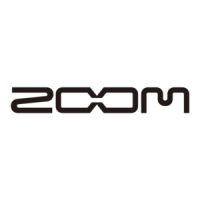
Do you have a question about the Zoom G1XN EXT and is the answer not in the manual?
| Brand | Zoom |
|---|---|
| Model | G1XN EXT |
| Category | Music Pedal |
| Language | English |
Explanation of an effect module as a combination of single effects.
Explanation of effect types within modules, like chorus or flanger.
Explanation of adjustable values that modify tone and effect intensity.
Definition of a patch as a stored combination of effect module settings.
Explanation of a bank as a group of ten patches.
Explanation of operating modes like play, rhythm, and edit.
Overview of top panel controls including Module selector, RHYTHM key, and VALUE knob.
Details on rear panel jacks like INPUT, DC IN, CONTROL IN, and OUTPUT/PHONES.
Overview of top panel controls including expression pedal and PEDAL ASSIGN key.
Details on rear panel jacks similar to G1N, including those for expression pedals.
Steps to turn on the unit and set it to play mode.
How to select patches using foot switches and switch between banks.
Procedure for adjusting the overall volume level using the VALUE knob.
How to switch the unit to bypass or mute condition for tuning.
Instructions on how to tune the guitar using the display indicators.
How to fine-tune the tuner's reference pitch using the VALUE knob.
Procedure to exit the tuner and return to normal play mode.
How to set the Module selector to the RHYTHM position.
How to start, stop, and manage the rhythm function playback.
How to choose patterns, adjust volume, and set tempo.
How to use the Module selector to choose an effect module for editing.
Using the VALUE knob to adjust parameters and change effect settings.
How to switch individual effect modules within a patch on or off.
Procedure to exit edit mode and return to play mode.
Pressing the STORE key to begin the process of saving or copying patches.
Using foot switches to choose the destination bank and patch number.
Pressing the STORE key again to complete the save or copy operation.
Procedure to reset all patches and settings to their original factory state.
Activating the pre-select mode by holding the ▲ foot switch during power-on.
Selecting a patch to use next without activating it immediately.
Confirming the pre-selected patch by pressing both foot switches.
Disabling pre-select mode by cycling power.
Connecting and using the optional foot switch for bank switching or tempo control.
Connecting and using an expression pedal for real-time parameter control.
Selecting which module the expression pedal controls.
Calibrating the expression pedal for optimal volume and tone control.
Using the expression pedal in play mode to change patch parameters.
Key to symbols used in parameter descriptions, like Module selector and Expression pedal.
Setting the overall volume level for each patch.
Details on Compressor and Auto Wah effect types and their parameters.
Explanation of various distortion and simulation effect types and parameters.
Details on adjusting the Low, Mid, and High frequency bands.
Explanation of Noise Reduction and Amp Simulation effects.
Details on Chorus, Ensemble, Flanger, and Pitch Shift effects.
Explanation of Delay, Tape Echo, Analog Delay, and Ping Pong Delay.
Details on Hall, Room, Spring, Arena, and Tiled Room reverb effects.
Technical details including effect types, patch memory, and power requirements.
Solutions for problems like no power, reverb not operating, or sound changes.
